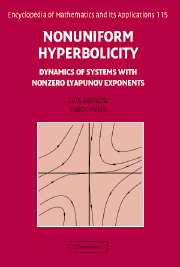Book contents
- Frontmatter
- Contents
- Preface
- Introduction
- Part I Linear Theory
- Part II Examples and Foundations of the Nonlinear Theory
- Part III Ergodic Theory of Smooth and SRB Measures
- 9 Smooth Measures
- 10 Measure-Theoretic Entropy and Lyapunov Exponents
- 11 Stable Ergodicity and Lyapunov Exponents. More Examples of Systems with Nonzero Exponents
- 12 Geodesic Flows
- 13 SRB Measures
- Part IV General Hyperbolic Measures
- Bibliography
- Index
9 - Smooth Measures
from Part III - Ergodic Theory of Smooth and SRB Measures
Published online by Cambridge University Press: 05 May 2013
- Frontmatter
- Contents
- Preface
- Introduction
- Part I Linear Theory
- Part II Examples and Foundations of the Nonlinear Theory
- Part III Ergodic Theory of Smooth and SRB Measures
- 9 Smooth Measures
- 10 Measure-Theoretic Entropy and Lyapunov Exponents
- 11 Stable Ergodicity and Lyapunov Exponents. More Examples of Systems with Nonzero Exponents
- 12 Geodesic Flows
- 13 SRB Measures
- Part IV General Hyperbolic Measures
- Bibliography
- Index
Summary
In the previous chapters of the book, we developed techniques and obtained a number of principal results on local behavior of trajectories (such as existence of local stable and unstable manifolds and absolute continuity of families of local manifolds), which will allow us to describe ergodic properties of nonuniformly hyperbolic dynamical systems with respect to some “natural” invariant measures. We consider two cases: smooth hyperbolic invariant measures and the physically important Sinai–Ruelle–Bowen (SRB) measures. The former case will be the subject of study in this and in the next three chapters, while the latter case will be discussed in Chapter 13.
Unlike the classical uniform hyperbolicity, the nonuniform hyperbolicity requirements are weak enough to allow presence of nonuniformly hyperbolic diffeomorphisms and flows on any smooth manifolds (see Theorems 11.4.1 and 11.5.1). Surprisingly, these requirements are strong enough to ensure abundance of ergodic properties: the ultimate result is the Spectral Decomposition Theorem 9.5.11, asserting that ergodic components of the system are of positive measure and the restriction of the system to every such component is Bernoullian (up to the discrete spectrum).
These results constitute the core of the smooth ergodic theory and were established in [168–170]. Our presentation follows these works, with necessary modifications and generalizations to include nonuniformly partially (not necessary completely) hyperbolic systems. This allows us to greatly expand the class of invariant measures under consideration to the so-called s- and u-measures (and, in particular, to SRB measures).
- Type
- Chapter
- Information
- Nonuniform HyperbolicityDynamics of Systems with Nonzero Lyapunov Exponents, pp. 261 - 303Publisher: Cambridge University PressPrint publication year: 2007

